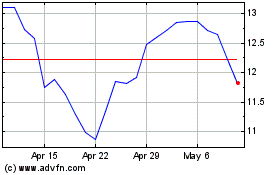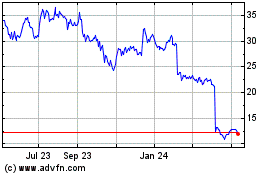Stock Market News for May 14, 2013 - Market News
May 14 2013 - 5:36AM
Zacks
Major indices finished mixed
following better-than-expected retail sales data and discouraging
economic reports from China. Investors are also concerned that, in
light of encouraging economic data, the Federal Reserve might
withdraw the monetary stimulus implemented since 2008. Of the top
ten S&P 500 industry groups, health care stocks were the
biggest gainers while materials stocks lost the most.
The Dow Jones Industrial Average
(DJI) lost 0.2% to close the day at 15,091.68. The S&P 500
gained 0.07 points to finish yesterday’s trading session at
1,633.77. The tech-laden Nasdaq Composite Index rose 0.1% to end at
3,438.79. The fear-gauge CBOE Volatility Index (VIX) decreased 0.3%
to settle at 12.55. Consolidated volumes on the New York Stock
Exchange, American Stock Exchange and Nasdaq were roughly 5.3
billion shares, well below 2013’s average of 6.36 billion shares.
Declining stocks outnumbered the advancers. For the 37% that
advanced, 59% declined.
According to the U.S. Department of
Commerce, retail sales for the month of April increased to 0.1%
compared to the consensus estimate of a decline of 0.3%. This was
also better than the previous month’s decline of 0.5%. Retail sales
grew unexpectedly on the back of robust car sales and expenditure
incurred on building supplies. Car sales, without which retail
sales would have declined by 0.1%, grew 1.0% in April. While
expenditure on gardening materials and building materials grew
4.7%, growth in departmental store sales increased 0.3%. Sales at
grocery stores decreased 1.2% while at gasoline stations by
4.7%.
According to another report
released by the U.S. Department of Commerce, manufacturers’ and
trade inventories in March remained flat on a sequential basis.
This data came in below the consensus estimate of 0.3%. However, on
a year over year basis it grew 4.5%. The inventory/sales ratio
increased to 1.29 from March 2012’s figure of 1.26.
According to a Wall Street Journal
report released over the weekend, the Federal Reserve is looking to
create an “exit strategy” for its monetary stimulus program. Since
2008, the Federal Reserve has been purchasing $85 billion worth of
treasuries and mortgage-backed-securities every month to boost the
economy. Now that the unemployment level is the same as it was in
the pre-recessionary period and important economic indicators have
remained positive over past two quarters, the Fed is considering
discontinuing or changing the pace of its monetary stimulus.
No specific timeline has been
provided by the Fed for these changes. However, last month the
Central bank did declare its willingness to "increase or reduce the
pace" of monetary stimulus. The increase or decrease of the
stimulus will depend on unemployment and the inflation numbers,
released from time to time. Currently, officials are deciding on
their future course of action. This is to ensure that panic does
not dominate the markets while withdrawing or changing the pace of
stimulus.
On the international front, China
released a bunch of discouraging economic reports. Industrial
output increased 9.3% year over year, higher than previous month’s
figure of 8.9%, but lower than the expected figure of 9.5%. Factory
orders for the world’s second largest economy dropped in April.
Decrease in new export orders is largely responsible for the
contraction.
A sub-index which measures new
export orders contracted to 48.4. This is the first time since
October 2012 that the index has fallen below 50. Non-rural fixed
asset investment from January to April period came in at 20.6%,
compared to estimates of 21% and also below January to March’s
figure of 20.9%. A string of discouraging numbers recently reported
by China has reinforced fears of a global slowdown in the minds of
investors.
On the earnings front, shares of
Perion Network Ltd (NASDAQ:PERI) surged 10.6% after its earnings
comfortably surpassed the Street’s expectations. The company
reported earnings of $0.22 a share, higher than the $0.04 cents a
share reported in the previous year. Strong earnings of the company
are attributable to its new Incredimail unified messaging
application for Apple Inc.'s iPad.
Of the top ten S&P 500 industry
groups, health care stocks gained the most. The Health Care SPDR
(XLV) gained 0.8%. Stocks such Johnson & Johnson (NYSE:JNJ),
Pfizer Inc. (NYSE:PFE), Merck & Co., Inc. (NYSE:MRK), Gilead
Sciences, Inc. (NASDAQ:GILD) and Amgen, Inc. (NASDAQ:AMGN)
increased 0.1%, 2.3%, 0.5%, 3.0% and 0.2%, respectively.
Materials stocks were the biggest
losers. The Materials Select Sector SPDR (XLB) lost 0.7%. Stocks
such as Monsanto Company (NYSE:MON), E I Du Pont De Nemours And Co.
(NYSE:DD), FMC Corp. (NYSE:FMC), the Dow Chemical Company
(NYSE:DOW) and Praxair, Inc. (NYSE:PX) lost 1.2%, 1.0%, 2.0%, 0.3%
and 0.8%, respectively.
AMGEN INC (AMGN): Free Stock Analysis Report
DU PONT (EI) DE (DD): Free Stock Analysis Report
DOW CHEMICAL (DOW): Free Stock Analysis Report
FMC CORP (FMC): Free Stock Analysis Report
GILEAD SCIENCES (GILD): Free Stock Analysis Report
JOHNSON & JOHNS (JNJ): Free Stock Analysis Report
MONSANTO CO-NEW (MON): Free Stock Analysis Report
MERCK & CO INC (MRK): Free Stock Analysis Report
PERION NETWORK (PERI): Get Free Report
PFIZER INC (PFE): Free Stock Analysis Report
PRAXAIR INC (PX): Free Stock Analysis Report
To read this article on Zacks.com click here.
Zacks Investment Research
Perion Network (NASDAQ:PERI)
Historical Stock Chart
From Jun 2024 to Jul 2024

Perion Network (NASDAQ:PERI)
Historical Stock Chart
From Jul 2023 to Jul 2024
